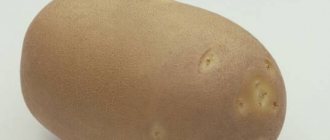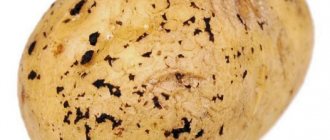It is always not easy for those who have just decided to try growing potatoes on their plot. The experience of previous generations, on the one hand, shows that this is not an easy task and requires good physical shape, on the other hand, there are so many varieties around that it can be dizzying. But you want everything to work out the first time, otherwise you’ll give up later. Therefore, beginners should take the choice of planting material very seriously so that their efforts are not in vain. And the variety must be proven and reliable. It’s as if the Aurora potato was created especially for beginners. In terms of reliability, unpretentiousness to various weather conditions and yield, few varieties of potatoes can compare with them, and they are also tasty. So, first things first.
Description of the variety
It’s best to start describing the Aurora potato variety with its history. This potato variety was obtained by a group of breeders from JSC Vsevolzhskaya Breeding Station more than 10 years ago. The same organization is also the originator of the variety. In 2006, it was registered in the State Register of Russia with recommendations for use in nine regions of Russia. It is interesting that these regions occupy almost the entire European part from the North to the North Caucasus and the Far Eastern region is separately included.
Attention! The Aurora potato is zoned in the European part of Russia almost everywhere - from the far north to the Black Sea.
Bushes of this variety are tall and powerful, so they receive more sunlight, but they also tend to fall apart. Therefore, hilling of these potato plants must be carried out repeatedly, otherwise most of the stems will simply lie on the ground. The leaves are also large, foliage is above average. The leaves themselves are light green, with slight waviness at the edges.
Potato bushes of the Aurora variety bloom for a short time, but very beautifully. The corollas of the flowers are large, violet-red in color.
Peculiarities
Characteristic features of Aurora:
- Climate resistance. Potatoes tolerate frost, drought, and constant rain. However, at a late stage of the growing season, bushes may fall under the pressure of squally winds;
- Adaptability to soil. "Aurora" survives on any soil, but produces maximum yield on light sandy loam, floodplain and soddy-podzolic soils.
Review of potato varieties Rosara, Red Scarlet, Bellarosa, Aurora:
Characteristics of the variety
The Aurora potato variety is mid-season in terms of ripening. That is, the harvest can be harvested 75–90 days after planting.
Potatoes have fairly high yields. On average, you can get 250-300 centners of potatoes from one hectare. The maximum yield is about 400 centners per hectare.
Comment! One potato bush can produce from 9 to 20 fairly large tubers.
The safety of potato tubers is also very good and amounts to 94%.
The characteristics of the Aurora variety would be incomplete if we did not mention its resistance to diseases. The Aurora variety is highly resistant to golden potato nematode and potato cancer. Resistance to late blight of tubers and the aboveground part of the bush is quite average.
Features of care
Caring for the Aurora variety is simple; the main measures include irrigating the soil, loosening, adding nutrients and protecting it from pests and diseases.
Hilling
You should start hilling the bushes after the first shoots appear. It is advisable to do this in dry weather, after which the plantings should be watered.
The second time the procedure is carried out when the height of the sprouts reaches 15-20 cm. It is good to combine it with the application of nitrogen preparations. It is effective to use saltpeter, nitroammophoska, and urea for such purposes. The granules scattered between the rows must first be embedded in the soil and then moistened abundantly.
The more often the hilling is carried out, the more actively the potatoes will grow.
Watering
Irrigation activities should not be done before the first shoots appear; there is enough moisture in the root crops to feed the sprouts. If there is too much water, the plant's root system will not be able to develop properly. It is recommended to carry out the first procedure for moistening the soil 5-7 days after the formation of sprouts.
The variety responds gratefully to frequent and abundant irrigation. Before the flowering phase begins, watering is done every 7 days, spending 2-3 liters of water on each plant. During the period of budding and tuber setting, the volume of water is increased to 3-5 liters.
On hot days, irrigation activities should be carried out in the evening. In the second half of summer, watering can be done at any time of the day; temperatures are no longer so high.
Top dressing
The number of feeding procedures is only 3 times:
- After the sprouts appear. At this stage, use urea or ammonium nitrate at the rate of 2 tsp. for each plant. Chicken manure also gives good results; it is enough to take 1 liter of it (diluted fertilizer) under a bush.
- At the budding stage. Use nitroammophoska (1 tbsp per plant), chicken, taking into account 1 liter of working solution.
- During the flowering period (tuber formation). Potassium magnesia is suitable here; it is added in the amount of 1 tsp. for each plant.
One of the best fertilizer compounds for potatoes is fermented bird droppings. It can be prepared using the following technology:
- Fill a suitable container halfway with dry chicken. When using pigeon droppings, fill the container to 1/2 of the total volume.
- Fill the litter with water to the top of the barrel and seal tightly.
- Let the solution sit for 3-4 days. This time is enough to form a concentrate of nutrients. The slurry can be stored until autumn.
- Before use, the liquid must be diluted at the rate of 1 liter of concentrate per 10 liters of clean water.
- Before use, potato plantings should be moistened, and then 0.5-1 liters of working solution should be added to each plant.
It is recommended to apply nitrogen compounds under the bushes before the formation of buds. When they appear, it is recommended to use potassium fertilizers to enhance tuber formation.
Disease and pest control
To protect potatoes from the invasion of the Colorado potato beetle, you will need to use such an effective drug as Confidor. The working liquid is prepared at the rate of 1 ml of product per 5-10 liters of water, it all depends on the extent of the damage. Treatments are carried out as needed, but no later than 20 days before harvesting root crops.
The drug Prestige, which is diluted with 15 ml per 300 ml of water, will help get rid of wireworms. Spraying of potatoes is carried out once, before planting them in the ground.
It is possible to save the harvest from mole crickets with the help of Medvetox, where 2 tsp are added to each plant. facilities. The procedures are carried out during planting work and as the parasite appears.
If potato bushes have been affected by scab or brown rot, then you should use Fundazol. This potent agent is diluted in an amount of 1 ml per 1 liter of water. In the spring they need to process the seed.
Ridomil Gold works well against Alternaria and peronosporosis, where 50 g of the drug is used per 10 liters of water. The first time the working solution is applied before the rows are closed, and the second time after 2 weeks.
Characteristics of tubers
Potato tubers of the Aurora variety are distinguished by their oblong shape and rather large size. On average, the weight of one tuber ranges from 90 to 150 grams. But tubers weighing 300 and even 500 grams are quite common. The pulp is creamy in color. Starch content varies from 14 to 17%. This percentage of starch content allows you to enjoy crumbly, delicious boiled potatoes.
The color of the Aurora potato peel is light brown, the peel itself is smooth and thin. The tubers of this variety have a rather attractive appearance.
There are usually few eyes, they are small in size and not very noticeable, which creates comfortable conditions when peeling potatoes.
The marketability of tubers is quite good and ranges from 85 to 95%.
The taste characteristics are simply excellent. It is for its taste that Aurora potatoes are often chosen for replanting. You can use it to prepare almost any potato dish.
Growing rules
Getting a rich potato harvest is not difficult. However, so that all efforts are not in vain, you will have to follow a certain growing technology.
- Seed preparation
It is necessary to prepare tubers for planting a month in advance. To do this, they need to be placed in a cool and bright place.
Please note: the choice of planting material should be approached responsibly. Damaged and diseased specimens should be discarded immediately; they are not suitable for planting. In addition, you need to choose tubers with sprouts.
- Soil preparation
It is necessary to prepare the soil in the autumn. To do this, you need to add half-rotted manure to the ground, dig it up, and leave it until spring. If you weren’t able to apply fertilizer in the fall, don’t worry. This can be done with the arrival of spring. It is enough to fill the holes with compost, superphosphate or humus.
- Planting work
According to the description, Aurora potatoes can be grown in all regions. The depth of placement depends on the climate. The average depth is 10 cm. The row spacing should be 80 cm.
The tubers must be carefully placed in the hole and sprinkled with soil.
Advantages and disadvantages
The Aurora variety has many advantages, thanks to which it is planted year after year, even despite the emergence of new interesting varieties.
- High yield;
- Excellent taste - when boiled, the potatoes turn out aromatic and crumbly;
- Resistance to many diseases;
- Attractive presentation;
- Good keeping quality.
No shortcomings were noticed in the Aurora variety, except for its mid-ripening. In order to enjoy fresh potatoes as quickly as possible, you will have to choose from other, earlier varieties. But its productivity and good preservation of tubers allow you to provide your family with tasty and healthy potatoes for the whole winter.
Diseases and pests
"Aurora" is distinguished by strong immunity to diseases:
- Golden nematode;
- Mosaic;
- Malignant tumors;
- Late blight of tubers;
- Brown rot;
- Common scab;
- Alternaria blight;
- Downy mildew;
- Blackleg.
Selecting potato varieties:
The greatest difficulties during cultivation arise from pest attacks.:
- Colorado beetle. In plots of up to 10 acres, beetles are collected by hand. In large gardens, plants are sprayed with insecticides: Arrivo, Confidor. The best time for treatment is the second phase of development of the larvae, when they begin to eat the pulp of the leaves, but have not yet moved around the bush;
- Wireworm. An effective preventive measure is pre-planting treatment of root crops;
- Medvedka. Medvetox has proven itself to be an effective pest control product. The product is scattered over the beds and pushed into the mole crickets’ burrows.
Features of cultivation
Aurora potatoes, as you probably already understood, are not at all picky about growing conditions, but in order to get record yields, you still have to do everything possible to make the plants feel comfortable.
For faster and more reliable germination of tubers, they must be placed for gardening and germination in a bright and preferably cool place about a month before planting. To plant potatoes, you need to make sure that the soil has already warmed up sufficiently.
Advice! Look at the birch tree, if the first leaves have already bloomed on it, you can start planting potatoes.
Planting should be done in the manner accepted in your area - in the north it is better to do it in ridges, and in the south, on the contrary, deepening it into the ground to protect the tubers from drying out. However, the planting method also depends on the composition of the soil; on heavy soils, even in the south, it is better to plant potatoes in ridges.
This potato variety tolerates drought very well, so when grown in the middle zone, there may be no need for watering.
Hilling up Aurora potatoes will not only help protect the tubers from frost, but will also save a sufficient amount of moisture in the potato plantings. Since the variety is characterized by a sufficient height of the bushes, hilling continues until the beginning of flowering.
A good technique to allow the tubers to ripen as well as possible is to cut off the entire above-ground part of the potato about two weeks before harvesting. After harvesting, the tubers must be thoroughly dried and stored.
How to grow potatoes
Aurora does not belong to the whimsical varieties; it takes root almost throughout the entire territory of Russia. The main thing is to carry out proper pre-sowing treatment, which will help keep the seed healthy and grow a rich harvest.
Pre-sowing treatment
Preparation of tubers begins a month before sowing. They are carefully inspected and damaged and dark colored ones are removed. Potatoes weighing no more than 100 g are selected for sowing. The seed material is laid out in a bright and cool room for germination.
Immediately before planting, potatoes are treated with the fungicidal agent “Fitosporin”, which not only serves as a disinfectant, but also strengthens the plant’s immunity. When the sprouts reach 2 cm, you can begin planting.
Reference! Greening the tubers will preserve the seed material from rodents. The green color of the skin means an increased amount of solanine, which is poisonous to field mice.
Planting dates and scheme
As soon as the threat of return frosts has passed and the soil has warmed up to 10°C, begin planting potatoes.
The tubers are planted in prepared soil, dug up in the fall. For fertility, the dug soil is supplied with wood ash and humus.
In the spring, the soil is dug up again and holes 10 cm deep are prepared. Planting pattern: 30 cm – distance between holes, 70 cm – row spacing. After planting, the tubers are sprinkled with soil and moistened.
Attention! The tubers are placed in the holes with the sprouts facing up. This method of planting will ensure faster emergence of seedlings.
Further care for Aurora potatoes
Despite the fact that the variety is drought-resistant, it responds well to watering. With proper watering, fruiting increases.
Watering
Before the flowering period begins, plants are watered every week in the evening, spending at least 3 liters of water for each seedling. At the time of flowering, watering is increased if there is no rain at this time. In any case, you should focus on weather conditions and the level of humidity in the beds. To preserve the health of seedlings, the humidity level should not go beyond normal limits.
After watering, the soil is loosened to ensure air permeability of the soil. For full growth and development, roots need oxygen. Also, do not forget about weeding the potato beds. Many pests that are dangerous to the nightshade family live and reproduce in weeds, so weeds must be removed by the roots. Weeds prevent plants from growing and fruits from ripening, taking nutrients from the soil.
High hilling is carried out as needed, but at least three times per season. Tall seedlings lie on the ground, which can lead to the development of fungal diseases, especially when in contact with wet soil. To ensure that the bushes stand straight, the ground is raked as high as possible. The procedure also protects the tubers from sunlight, and they do not turn green.
Feeding
Organic compounds and a full range of minerals are used as fertilizers. Nitrogen is used only at the initial stage, two weeks after planting in the ground. Nitrogen helps to increase the green mass and height of the plant, but if you feed it with nitrogen throughout the growing season, then all the nutrients will be spent on leaf growth and not on the formation of tubers.
During flowering, fertilize with organic matter, use an infusion of bird droppings in a ratio of 1:10 and pour it between the rows after abundant watering.
At the time of fruiting, they are fed with phosphorus and potassium for faster formation and ripening of tubers.
All fertilizing is either combined with watering or applied to well-moistened soil.
Disease and pest control
Due to the susceptibility of seedlings to late blight, preventive measures are systematically carried out. These include:
- compliance with crop rotation rules;
- moderate watering;
- systematic loosening and hilling;
- timely application of fertilizers;
- treatment with fungicidal agents.
It is important to inspect the seedlings daily for changes and the presence of pests in order to take immediate action.
To treat late blight, the contact fungicide “Fitosporin” is used. Plants are also sprayed with it for preventive purposes.
When there is a large concentration of the Colorado potato beetle, use the drug “Prestige” or “Confidor”. If the pest is small, it is collected manually along with the larvae.
For mole crickets, Medvetox is used . The granules are buried 2 cm into the ground, since the mole cricket moves underground. Folk methods are also used against this insect: crushed heads of garlic and fish heads, which, like Medvetox granules, are buried several centimeters into the ground.
Reviews from gardeners
Despite the fact that the Aurora potato variety has been grown for just over 10 years, it has received many excellent reviews from people who have already added it to their favorites and do not intend to change their preferences in the coming years.
Larisa, 45 years old, Nizhnevartovsk
I really like Aurora potatoes. I’ve been planting it for three years now, and I don’t intend to change it to any Dutch varieties yet. Firstly, I get 400-500 kg of potatoes from one hundred square meters. It seems to me that this is a very good harvest, and the potatoes are tasty and boil well. All of mine eat with great appetite. And then it is stored well. I just left a box of potatoes in the kitchen, and we ate them for a long time and they didn’t spoil at all.
Mikhail, 52 years old, Voronezh
We have been planting this variety for several years. I once bought high introduction tubers, and I immediately really liked its yield. I left almost everything for seeds that year. And then he scammed her himself. Last year I collected about two tons from four acres of plantings. I also grow it for sale. Buyers like its shape and, in general, its appearance is very attractive. And if you boil it, and with a crispy cucumber, you don’t need anything else. Worthwhile variety!
Elena, 38 years old, Krasnodar
We tried many varieties of potatoes, but among the mid-season varieties, Aurora was and remains one of our favorites. Potatoes are very tasty and keep well. And it’s also a sin to complain about the harvest. Last year the weather was hot, the summer was dry, and without watering almost all the potatoes did not grow, they simply withered on the vine. Only Aurora helped us out; if it weren’t for her, we would have been left without potatoes for the winter.
Landing
In order to get a good harvest, you need to plant the plant correctly. Potatoes are very light-loving, so choose a completely open area.
Advice! Signs of good planting material are smooth and undamaged tubers the size of a large chicken egg. The sprouts should be strong, about 1–2 cm long.
Good planting material is the key to a rich harvest
Soil preparation
- In autumn, half-rotted manure (4–5 buckets per 10 sq. m) and superphosphate (about 1 cup per 10 sq. m) are scattered on the ground. After this, the soil is dug well and left until spring. If for some reason this was not possible, you can apply fertilizer directly into the holes when planting. To do this, pour a handful of humus or compost and a small pinch of superphosphate or nitroammophoska under each bush.
Important! In spring, under no circumstances should fresh manure be added. The excess nitrogen contained in it will lead to a decrease in the quality of the tubers.
- To protect against pests, potatoes are treated with special preparations immediately before planting. Typically, the effect of these products continues until the beginning of tuberization; all this time, the potatoes are not touched by Colorado potato beetles, wireworms, and other pests. The best insectofungicidal preparations for dressing are:
- Prestige;
- Matador;
- Maksim.
- In addition, shortly before planting, the tubers are vernalized. This increases plant resistance to disease and has a beneficial effect on future harvests. If you plan to plant potatoes at the end of April, then in the last days of March they are taken out of the basement, laid out in low boxes in 1-2 layers and left in a bright, cool place. For these purposes, a bright veranda or a glazed balcony is usually used. When exposed to light, the tubers turn green and produce strong, short shoots.
Landing technology
Tubers are planted in open ground after the onset of stable warm weather with an average temperature of at least +10°C.
To prevent the tall, spreading bushes of Aurora from interfering with each other, the row spacing is made as wide as possible for potatoes (60–80 cm). Place the tubers very carefully, avoiding damage to the young shoots. Then sprinkle with earth about 10 centimeters.
Important! The heavier the soil and the lower the average daily temperature, the smaller the tubers are planted. On loose soils in warm climates, potatoes are planted to a depth of 15 cm, and in more northern regions with dense soil, a hole depth of 8–10 cm is maintained.
Place the tubers in the holes carefully so as not to damage the sprouts
Reviews of potatoes by those who planted and grew the variety
Ekaterina, 44 years old, Nizhnevartovsk: I have been growing potatoes in my garden for more than one year. We plant several acres of this vegetable crop to store it for the whole winter. I have tried many varieties, and as a result, for the last few seasons we have been growing only the Aurora variety. Of the mid-season varieties, I liked it the most - a variety with high yield (we get up to 450 kg of tubers from every hundred square meters), excellent taste and presentation of the tubers. They boil well and lie in the cellar almost until the end of spring.
Sergey, 50 years old, Voronezh region: The Aurora potato variety was first planted on the plot a couple of seasons ago. In the first year we planted a couple of beds to test. Productivity turned out to be high. We left some of it for food, but most of it was put aside for seeds for planting next year. We liked the Aurora potatoes both for their taste and their beautiful appearance. Last year I planted 4 acres of potatoes of this variety - they reaped a very decent harvest. We also put it underground for food, and sold some of it - the buyers were absolutely delighted with our potatoes. Next season we also plan to grow this variety not only for our own needs, but also for sale. I recommend it to all gardeners.
Thanks to a lot of positive qualities, the Aurora potato variety is popular among many vegetable growers in the European part of Russia.










